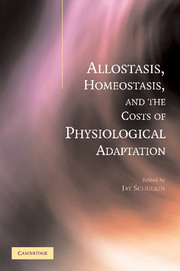Book contents
- Frontmatter
- Dedication
- Contents
- Preface
- Contributors
- Introduction
- 1 Principles of Allostasis: Optimal Design, Predictive Regulation, Pathophysiology, and Rational Therapeutics
- 2 Protective and Damaging Effects of the Mediators of Stress and Adaptation: Allostasis and Allostatic Load
- 3 Merging of the Homeostat Theory with the Concept of Allostatic Load
- 4 Operationalizing Allostatic Load
- 5 Drug Addiction and Allostasis
- 6 Adaptive Fear, Allostasis, and the Pathology of Anxiety and Depression
- 7 A Chronobiological Perspective on Allostasis and Its Application to Shift Work
- 8 Allostatic Load and Life Cycles: Implications for Neuroendocrine Control Mechanisms
- Commentary: Viability as Opposed to Stability: An Evolutionary Perspective on Physiological Regulation
- Index
1 - Principles of Allostasis: Optimal Design, Predictive Regulation, Pathophysiology, and Rational Therapeutics
Published online by Cambridge University Press: 05 February 2015
- Frontmatter
- Dedication
- Contents
- Preface
- Contributors
- Introduction
- 1 Principles of Allostasis: Optimal Design, Predictive Regulation, Pathophysiology, and Rational Therapeutics
- 2 Protective and Damaging Effects of the Mediators of Stress and Adaptation: Allostasis and Allostatic Load
- 3 Merging of the Homeostat Theory with the Concept of Allostatic Load
- 4 Operationalizing Allostatic Load
- 5 Drug Addiction and Allostasis
- 6 Adaptive Fear, Allostasis, and the Pathology of Anxiety and Depression
- 7 A Chronobiological Perspective on Allostasis and Its Application to Shift Work
- 8 Allostatic Load and Life Cycles: Implications for Neuroendocrine Control Mechanisms
- Commentary: Viability as Opposed to Stability: An Evolutionary Perspective on Physiological Regulation
- Index
Summary
INTRODUCTION
This chapter compares two alternative models of physiological regulation. The first model, homeostasis (“stability through constancy”), has dominated physiology and medicine since Claude Bernard declared, “All the vital mechanisms … have only one object – to preserve constant the conditions of … the internal environment.” His dictum has been interpreted literally to mean that the purpose of physiological regulation is to clamp each internal parameter at a “setpoint” by sensing errors and correcting them with negative feedback (Fig. 1.1; Cannon, 1935). Based on this model, physicians reason that when a parameter deviates from its setpoint value, some internal mechanism must be broken. Consequently, they design therapies to restore the “inappropriate” value to “normal.”
The homeostasis model has contributed immeasurably to the theory and practice of scientific medicine, so to criticize it might almost seem absurd. Yet all scientific models eventually encounter new facts that do not fit, and this is now the case for homeostasis. In physiology, evidence accumulates that parameters are not constant. Their variations, rather than signifying error, are apparently designed to reduce error. In medicine, major diseases now rise in prevalence, such as essential hyper-tension and type 2 diabetes, whose causes the homeostasis model cannot explain. For in contrast to the hypertension caused by a constricted renal artery and the diabetes caused by immune destruction of insulin-secreting cells, these newer disorders present no obviously defective mechanism. Treating them with drugs to fix low-level mechanisms that are not broken turns out not to work particularly well. The chapter expands on each of these points.
The second model, allostasis (“stability through change”), takes virtually the opposite view. It suggests that the goal of regulation is not constancy, but rather fitness under natural selection. Fitness constrains regulation to be efficient, which implies preventing errors and minimizing costs. Both needs are best accomplished by using prior information to predict demand and then adjusting all parameters to meet it (Fig. 1.1).
- Type
- Chapter
- Information
- Publisher: Cambridge University PressPrint publication year: 2004
- 128
- Cited by

